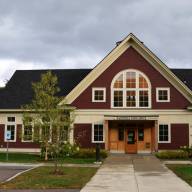Local volunteers who monitor the Mad River bimonthly report this week on how stream buffer improvements benefit birds.
On July 20 and 21, Mad River Watch volunteers visited their field sites to collect data and make environmental observations.
“We are always talking about the ecological benefits of healthy riparian buffers,” said Marcy Bucheit, Friends of the Mad River watershed engagement coordinator. “These areas of vegetated land along streams and rivers provide a wide range of benefits from stabilizing riverbanks to filtering pollutants to providing shade to cool water temperatures. This summer, in collaboration with our partners at Audubon Vermont, we are bringing attention to the benefits that riparian buffers provide for birds. Many species rely on riverside habitat for foraging, breeding, and shelter; intact riparian buffers help support healthier birds.”
NOT ALL BUFFERS ARE EQUAL
“What is the recipe for success in a buffer to support birds? It begins with a diversity of native plants,” explained Bucheit. “The fruits of invasive vegetation, like common buckthorn and bush honeysuckle, provide poor nutrition compared to native species. Eliminating the bird “junk food” of invasive species opens up space for native plants which are better suited to bird diets.”
In a buffer of native species, birds benefit the most from a biodiverse variety of plants with different ages and heights. The presence of a shrubby understory, such as willow or dogwood, provides species like willow flycatcher and yellow warbler the shrubby habitat they need for nesting or perching. Mature canopy supports species like the pileated woodpecker by providing places for nesting cavities and insect foraging.
“When it comes to the width of a riparian buffer, the number we often reference as a target benchmark for landowners is 50 feet,” added Bucheit. “And the 50-foot standard is great for many of the bank stabilization and water temperature reduction benefits we’re going after. However, when we consider riparian buffers and bird habitat, as wide as possible is the best.”
Birds that prefer edge habitat like the northern cardinal or the gray catbird can be found in buffers as small as 10 feet. In a 50-foot buffer, species like the hairy woodpecker or the red-eyed vireo will be present. However, sensitive species that need undisturbed habitat, such as the scarlet tanager, will typically not be seen until the buffer is 150-feet or wider. For this reason, a wider buffer will help support a greater diversity of birds in that buffer.
BIRDS AS THE HOOK
“Birds are charismatic and we all love seeing or hearing distinctive species,” Bucheit noted. “If landowners want to plant trees, practice no mow, or manage invasive species in order to see more birds, that’s amazing! In the process, they’ll also be benefitting water quality, stream habitat and the climate resiliency of our landscape. We encourage any landowner interested in this work to get in touch with us.”
NOTES FROM THE FIELD
This week, volunteers were asked to do some birdwatching at their sites and report back who they’d found. Some species were common across multiple sites including song sparrow, blue jay, American robin, black-capped chickadee, red-eyed vireo, American goldfinch, and common yellowthroat. However, some unique observations were made at particular sites. At Riverside Park, a volunteer heard a redstart and an alder flycatcher. At Mill Brook, a volunteer spotted an Eastern phoebe and a belted kingfisher. At Warren Covered Bridge, a yellow-bellied sapsucker was heard.
The lack of rain and warm summer weather the last few weeks was highlighted in many observations of low flow levels. Water temperatures ranged from a low of 55F at 7:30 a.m. Monday at Chase Brook to a high of 76F at 12:30 p.m. Sunday at Mill Brook.
Photo by: Jen Bennett













